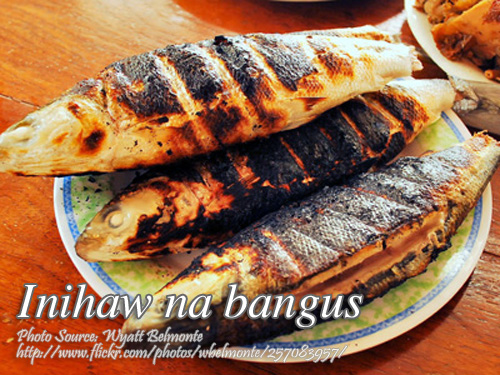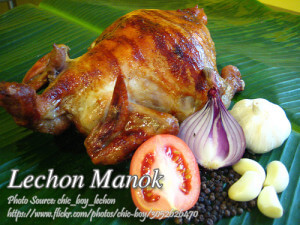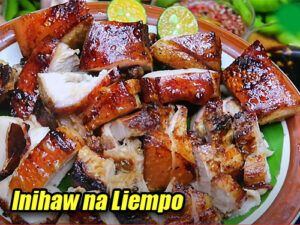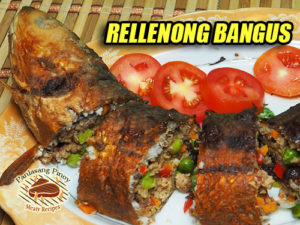This is a recipe of grilled milk fish stuffed with onions and tomatoes then wrapped with banana leaves. Also known as inihaw na bangus, cooking this grilled fish is best on hot charcoal. And there are also other options on wrapping it. If banana leaves are not available, you can use aluminum foil.
But sometimes I prefer not wrapping it with anything at all because I want the scales and skin to be roasted well. But if the coals are too hot, you might burn the scales and the skin so the technique it don’t put too many charcoals and adjust the grills distance higher from the coals.
Inihaw na Bangus: A Family Favorite on the Grill
Whenever my family gathers for the summer fiesta in our hometown in Pangasinan, one dish never fails to make its way to the table—inihaw na bangus. My Uncle Renato, who swears by his own technique of grilling, always insists that the best way to enjoy milkfish is stuffed with fresh tomatoes and onions, then wrapped snugly in banana leaves. I grew up watching him prepare it, the smoke from the charcoal fire carrying that distinct aroma of grilled fish that meant another feast was about to begin.
Why Milkfish is Always on the Menu
Bangus is our national fish for good reason. Not only is it affordable and easy to find in wet markets across the country, but it’s also incredibly versatile. In Pangasinan, where my cousin Marites lives, families often raise bangus in fishponds, making it a staple on the dining table. While some prefer it fried to a crisp or simmered in sour broth, nothing beats the smoky flavor of grilled milkfish stuffed with tangy tomatoes and sweet onions. That combination alone feels like home.
How I Learned the Technique
When I first tried grilling this dish on my own, I made the mistake of placing the fish directly over blazing hot charcoal. The result? Burnt skin and undercooked stuffing. It was my brother-in-law, Kuya Mario, who showed me the trick—spread the coals evenly, keep the fire moderate, and raise the grill just a little higher. By doing so, the heat cooks the fish gently while keeping the skin from burning. This simple technique works because it allows the flesh to cook through evenly while the natural oils of the bangus lock in the flavor.
Banana Leaves, Foil, or Naked on the Grill?
There’s a long-running debate in our family about how to wrap grilled milkfish. My Auntie Lorna insists on using banana leaves because they give the fish a subtle earthy fragrance. My cousin Joey, on the other hand, prefers aluminum foil since it prevents the fish from drying out. Personally, I like both depending on the mood. Sometimes, I skip wrapping altogether just to enjoy the crisp roasted skin, though it requires careful attention so the fish doesn’t burn. The key is adjusting the distance of the grill and not overloading the charcoal fire.
Stuffing that Makes the Difference
The stuffing of onions, tomatoes, and kinchay isn’t just for flavor—it also keeps the inside of the bangus moist while grilling. The juices seep into the flesh, balancing the smokiness of the charred skin with bursts of freshness in every bite. My Lola Pilar used to remind us never to skimp on the stuffing because that’s what makes this dish truly irresistible. She even drizzled a bit of fish sauce on the mixture before sealing it in, a trick I still follow today.
Food for Thought: The Tradition of Grilled Fish
Inihaw dishes have long been part of Filipino culture, often prepared during fiestas, town gatherings, or simple beach outings. Before modern cookware, people relied on open fires and banana leaves not just for convenience, but for the depth of flavor they impart. Grilling bangus connects us back to that tradition. It’s more than just cooking—it’s a celebration of family, community, and the abundance of the sea. Even today, many coastal towns in Luzon and Visayas still highlight inihaw na bangus in their festivals, showcasing its place in our culinary identity.
Cooking Tips for Beginners
If you’re new to grilling, don’t be intimidated. Start with a cleaned milkfish—your vendor in the wet market can even do the slitting for you. Make sure the fish is well-drained before seasoning to prevent steaming instead of grilling. Rubbing oil or butter on the skin before it hits the grill gives it a golden sheen and adds a layer of flavor. Most importantly, take your time. Turn the fish gently and allow both sides to cook evenly. Grilling is as much about patience as it is about heat.
A Dish That Brings People Together
Every time I cook inihaw na bangus, I’m reminded of afternoons spent by the seashore with cousins, waiting eagerly as the fish sizzled over the fire. It wasn’t just about the meal but the laughter, the stories, and the feeling of belonging. To this day, whenever I catch a whiff of grilled milkfish, I’m transported back to those moments. And maybe that’s why this dish continues to be a favorite—it’s not just food, it’s a memory served on a plate.
How to Cook Inihaw na Bangus with Stuffings
Ingredients
- 1 pc large sized bangus milkfish
- 2 Tbsp vegetable oil or coconut oil or butter
- salt and pepper for seasoning the fish
- Banana leaves for wrapping
- aluminum foil optional
For the Stuffing:
- 2 pcs onion chopped finely
- 3 pcs tomatoes chopped finely
- 2 Tbsp kinchay chopped
- 1 Tbsp Patis
- 1 tsp black pepper
Instructions
How to Cook Inihaw na Bangus (Grilled Milk Fish)
- Clean bangus but do not scrape scales. With a sharp knife slit the back to make an opening up to the stomach or abdomen.
- This can be done by the fish vendor when you buy it in the wet market, but in a supermarket you have to buy it whole and do the procedure above.
- Wash the fish and drain until dry. Mix onions, tomatoes, kinchay and patis together in a bowl.
- Season the fish with salt and pepper. Stuff the mixture inside the bangus.
- Rub the fish with 2 Tbps. vegetable oil or butter before grilling to enhance flavor.
- Wrap bangus in wilted banana leaves. Then wrap it again in aluminum foil to avoid burning the leaves and to keep the fish moist.
- Grill on hot charcoal for 1/2 hour turning the fish on the other side to avoid burning the skin.
Video
Notes
Cooking Tips:
Control the Heat of Your Charcoal
A common mistake is grilling bangus over flames that are too hot, which can burn the skin before the inside is cooked. Spread the charcoal evenly and keep the heat at medium to allow the fish to cook gently. This technique ensures the flesh stays moist while giving the skin a nice char.Don’t Skip the Stuffing
The mix of tomatoes, onions, and kinchay doesn’t just add flavor—it keeps the fish juicy as it grills. As the vegetables cook, their natural juices seep into the bangus, balancing the smoky taste with freshness. Always pack the stuffing generously to enjoy that burst of flavor in every bite.Wrap Smart for Best Results
Banana leaves add an earthy aroma, while foil helps trap moisture and prevent burning. If you prefer crispy skin, you can skip the wrap but keep a close eye on the grill. Choosing the right method depends on whether you want extra fragrance, tenderness, or crispness in your inihaw na bangus.






Leave a Reply